The Battle of Rivoli (Veronese): (14th January, 1797)
At 2am, on the 14th of January, Napoleon arrived at Rivoli and observed the Austrian positions. He could see the fires of at least five of the six camps, as best described on page 116 of Chandler's book when Napoleon joined Joubert in overlooking the enemy positions:Joubert in overlooking the enemy positions:
"The scene was lit by superb moonlight," wrote Bonaparte, "We scaled the different heights and observed the lines of the enemy camp fires; they filled the space between the Adige and Lake Garda... we could easily distinguish five camps, each belonging to a column."
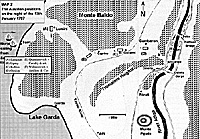 In fact there were six lots of camp fires. One was Lusignan's camp near Lumini, another Liptay's at Caprino, the rest were Koblos at St. Giovanni, Ocskay at Gambaron, Quasdanovich near Incanale (Canale) and Wukassovich on the east bank of the Adige at Dolce (SEE MAP 2).
In fact there were six lots of camp fires. One was Lusignan's camp near Lumini, another Liptay's at Caprino, the rest were Koblos at St. Giovanni, Ocskay at Gambaron, Quasdanovich near Incanale (Canale) and Wukassovich on the east bank of the Adige at Dolce (SEE MAP 2).
From their positions Napoleon was able to work out Alvinci's plan of attack. Apart from Lusignan's command, the other five columns would have to attack uphill. He also worked out that possibly half the Austrian troops, and most of their cavalry and artillery, appeared to be situated on the east and west banks of the Adige river. From his previous knowledge of the area Napoleon also knew that these troops could only attack Rivoli via the narrow and steep Osteria Gorge. And to do so they would first have to clear the ridge of Monte Magnone and control the high ground.
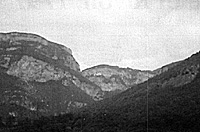 On the high ground stood the Chapel of San Marco. Not only would holding the chapel split the Austrian attack in two but from it they could observe all the Austrian movements in the gorge and the Adige Valley area.
On the high ground stood the Chapel of San Marco. Not only would holding the chapel split the Austrian attack in two but from it they could observe all the Austrian movements in the gorge and the Adige Valley area.
At left, chapel (middle center)
Hold the High Ground
Napoleon planned to hold this high ground position until Rey's Division arrived and in order to let Massena's brigades rest from their overnight march. Holding the position would also mean that most of Alvinci's artillery could only come into action against the French right flank. Napoleon realised he needed a delay; something to hold back Alvinci's attacks until Rey's arrival. His solution was to order the outnumbered French to launch an attack first, with the sole aim of upsetting Alvinci's plans.
Joubert was ordered back to the Rivoli area. One of his brigades, commanded by General Baron W. Vial, was to hold San Marco Chapel and Osteria village (or hamlet) while the rest were to be positioned opposite Liptay, Koblos and Ocskay's columns. (It must be noted that many accounts vary as to the names of the various places upon the battlefield. Although I've included Osteria village, some accounts mention Della Dogana Inn and Chandler uses San Marco Village. This, of course, all adds to the fun of researching!) Massena's Division was held in reserve at Rivoli while the brigade nearest to Lake Garda was to block Lusignan's column advancing towards the French left flank.
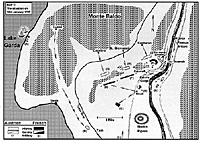 Joubert's troops were in position around 4am on the 14th (SEE MAP 3). The brigade sent to hold San Marco arrived just in time to drive some Austrians off Monte Magnone.
Joubert's troops were in position around 4am on the 14th (SEE MAP 3). The brigade sent to hold San Marco arrived just in time to drive some Austrians off Monte Magnone.
At first light, Joubert, with the rest of his Division, attacked Caprino and St. Giovanni with about 9,700 infantry, 500 cavalry and about 12 guns, but was held back by the Austrians who outnumbered his own troops. At 9am the two Austrian columns commanded by Koblos and Liptay outflanked and routed Joubert's troops; the 85th and possibly the 29th Demi-Brigades were said to have run away.
Napoleon quickly rushed one of Massena's brigades, said to be the 14th Demi-Brigade, led by Massena, to Joubert's aid. After some fierce fighting and although still tired from their enforced overnight march, they managed to bring the Austrian attack to a halt. During this action Massena was nearly captured. Meanwhile, Quasdanovich and Wukassovich had finally made a move and had begun to attack the French positions on the right. Wukassovich had placed several gun batteries opposite Osteria, and their heavy fire, combined with the assaults by Quasdanovich's cavalry and infantry, forced the French out of the village.
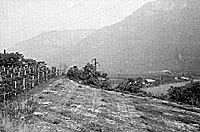 The road through the defile to Rivoli was now clear. (If Wukassovich did indeed command a pontoon train, due to the heavy fire from the French infantry and artillery, he may not have been able to attempt throwing it across the Adige until now. Unfortunately, he didn't appear to try and another opportunity slipped by).
The road through the defile to Rivoli was now clear. (If Wukassovich did indeed command a pontoon train, due to the heavy fire from the French infantry and artillery, he may not have been able to attempt throwing it across the Adige until now. Unfortunately, he didn't appear to try and another opportunity slipped by).
River Adige bends to right and then left upwards and northwards
However, before Quasdanovich could advance along the road, he needed to clear San Marco Chapel and the part of Monte Magnone which overlooked it and which was now held by a French brigade.Demi-Brigade, led by Massena, to Joubert's aid. After some fierce fighting and although still tired from their enforced overnight march they managed to bring the Austrian attack to a halt. During this action Massena was nearly captured.
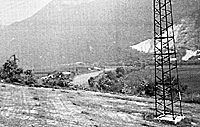 Meanwhile, Quasdanovich and Wukassovich had finally made a move and had begun to attack the French positions on the right.
Meanwhile, Quasdanovich and Wukassovich had finally made a move and had begun to attack the French positions on the right.
At right, River Adige heads left and northward. Quasdanovich advanced along left side of photo towards camera. Wukassovich advanced on right, with perhaps some batteries placed on right hand side of the bend.
Wukassovich had placed several gun batteries opposite Osteria, and their heavy fire, combined with the assaults by Quasdanovich's cavalry and infantry, forced the French out of the village. The road through the defile to Rivoli was now clear. (If Wukassovich did indeed command a pontoon train, due to the heavy fire from the French infantry and artillery, he may not have been able to attempt throwing it across the Adige until now. Unfortunately, he didn't appear to try and another opportunity slipped by). However, before Quasdanovich could advance along the road, he needed to clear San Marco Chapel and the part of Monte Magnone which overlooked it and which was now held by a French brigade.
Around this time, Lusignan's column had pushed back the brigade Massena sent to hold it and had now reached Affi, which was almost in the rear of the French positions. If they were allowed to advance any further the Austrians could prevent the French retreating and also stop reinforcements from arriving.
Looks Bad
At 11am, the situation on all fronts looked bad for Napoleon. The French were under pressure from constant Austrian attacks and Quasdanovich was about to advance up the Osteria Gorge, his Grenadiers having captured the village. Austrian dragoons had also charged up the gorge and grabbed a foothold on the Rivoli plateau and three infantry battalions were rushing up in support. Even though the situation looked grim, Napoleon didn't panic. He was sure his men could hold the tiring troops of Liptay, Koblos and Osckay.
However, in order to combat the growing pressure on the right, he took the gamble of moving some of Joubert's men to face the threat from Quasdanovich. As the Austrians advanced towards Rivoli the French formed into a massed infantry column, and, along with 500 cavalry led by General Victor Emmanuel Leclerc, which included the 1st Heavy Cavalry regiment, attacked them. They were supported by artillery, said to include a light horse battery, that poured canister into the concentrated Austrian ranks. During the intense fighting that followed a lucky shot blew up an Austrian ammunition wagon (some accounts say two or more) causing severe casualties, This, combined with the French infantry and cavalry attack, finally drove the Austrians back.
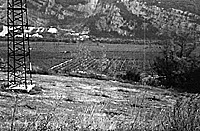 The constant fire from the French guns began to take its toll and Quasdanovich ordered his troops to withdraw to Incanale out of artillery range. (The sight of this may have also caused Wukassovich to forget the bridging attempt, if indeed he had actually begun it, and had probably also persuaded him to order a retreat.)
The constant fire from the French guns began to take its toll and Quasdanovich ordered his troops to withdraw to Incanale out of artillery range. (The sight of this may have also caused Wukassovich to forget the bridging attempt, if indeed he had actually begun it, and had probably also persuaded him to order a retreat.)
At right, View of fields where Wukassovich guns and command may have been placed (facing camera).
Meanwhile, Lusignan, unaware of what was happening, pushed on and captured Monte Pipalo, in the hope of cutting the French Lines of Communication. Napoleon sent Massena's reserve brigade (possibly the 18th Demi-Brigade) and artillery, commanded by General Guillaume Marie Anne Brune to attack him, and, at the same time, the troops of Rey's Division began to appear on the scene and the Austrians found themselves attacked on two fronts.
The combination of marching, fighting and lack of food must have exhausted Lusignan's troops by now, and, finding themselves surrounded, it's not surprising they were defeated. Half of the troops in Lusignan's column were made prisoner and he just about managed to escape.and artillery, commanded by General Guillaume Marie Anne Brune to attack him, and, at the same time, the troops of Rey's Division began to appear on the scene and the Austrians found themselves attacked on two fronts. The combination of marching, fighting and lack of food must have exhausted Lusignan's troops by now, and, finding themselves surrounded, it's not surprising they were defeated. Half of the troops in Lusignan's column were made prisoner and he just about managed to escape.
Attention Turns to Columns
Once Quasdanovich had retreated and Lusignan's column destroyed, Napoleon turned his attention back to the columns of Liptay, Koblos and Ocskay which had renewed their attacks. He rushed all available troops to combat them, including some light cavalry commanded by Count Antoine Charles Lasalle. The Austrians fought ferociously and attacked repeatedly, but without cavalry and little artillery support they were beaten back. Koblos and Ocskay's columns were in turn panicked by the vigorous charges made by the French cavalry and thrown back in confusion, losing many prisoners in the process. Only Liptay's column managed to remain calm and retreated in order back to Caprino.
Between 2-3pm Alvinci's army was in full retreat and Napoleon was about to pursue when word arrived that Provera had crossed the Adige and was making for Mantua. Rey and Joubert were quickly ordered to continue the pursuit of the retreating Austrians, which turned into a rout. However, on the 15th, Alvinci, unaware of Lusignan's defeat, felt obliged to try and come to his aid and to attempt once more to break through to Mantua. He tried to concentrate what troops he could at La Corona and attacked Joubert. It was all too much for the weary and underfed Austrians, many of whom had seen little, if any food over the last few days. Their half-hearted assaults were beaten back and Murat, who had marched across country from Torri, appeared in their rear and moved to cut off their retreat. Joubert then counterattacked driving the Austrians into a rout,. When the French called a halt to the pursuit, the Austrians under Alvinci's direct command had lost 3,000 men killed and 11,000 prisoners, which equalled half of his original attacking force. However, it is reported in some accounts that on the 16th, less than 7,000 of the original 28,000 returned to their starting point! The French losses were not as high but still heavy, numbering somewhere In the region of at least 2,000 killed in action.
Continues next issue with Provera's attack, OB's etc.
More in the Series
Back to Table of Contents -- First Empire #25
Back to First Empire List of Issues
Back to MagWeb Master Magazine List
© Copyright 1995 by First Empire.
This article appears in MagWeb (Magazine Web) on the Internet World Wide Web. Other military history articles and gaming articles are available at http://www.magweb.com